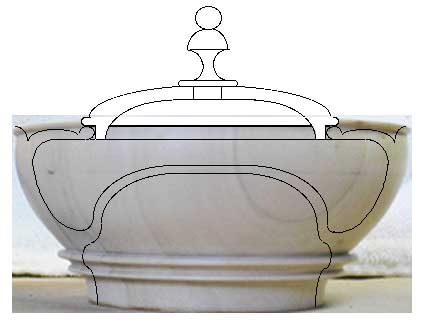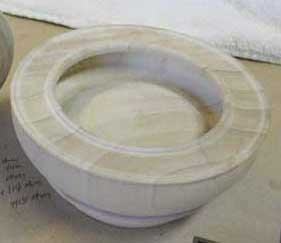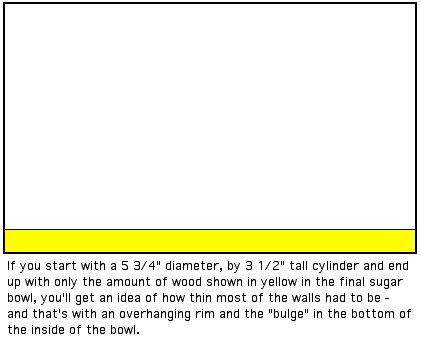No Response From HexBug - Now What?
Lacking any response from the HexBug folk regarding a lower geared CRAB, and with my reluctance to drill any more holes in Attempt #1, I looked around the shop for a chunk of DRY wood. It had to be large enough for a 5 1/2" to 6" diameter by three or four inches tall piece to hide the Bot under. Found a chunk of what may be silver maple, or it might be birch - or beech.
Here's PLAN #2 - a sugar bowl - that scurries when startled. Note the inward overhang of the top. So much for K.I.S.S. While I was at it, I added some beads, figuring if push comes to shove on the Weight Thing, I could turn them off if it came to than. The picture is about LIfe Size

Now you're asking the obvious - "Why put a lid - with finial - on this thing when weight is an issue?"
Thre's a Method To The Madness. The piece will be displayed with the lid off to reveal the "sugar" inside - thus identifying it as a Sugar Bowl - a turned piece that has an actual, practical use - and thus misleading the viewer / particpant in this little game.
At about half the size of Attempt #1, and starting with dry - and lighter - wood to begin with, I figured I'd easily get Attempt #2 down to 100 grams without much effort - or worry. Getting it down to 62 grams - or less - would take some doing, but at least I would be able to see MOST of the internal hollowing cuts

Here's the bottom and the top views of this thing. At this point it was down to about 80 grams


From this point on I was about four hours of work on this piece and entering High Risk Territory - very very light cuts, back lighting to identify potential TOO THIN! areas, a blast of compressed air and a trip to the triple beam balance for a weigh in. 72 grams. "ONLY" ten more grams to get rid of.
Carefully turn some more, check for TOO THIN areas, blow out the dust - weigh again - 68 grams! A "mere" 6 grams to go.
From that point on it was 80 GRIT Time - sand a little off here, some off there, check for TOO THIN!, reverse chuck the piece, 80 grit some more, blow out the dust, weigh it again. In an hour I'd removed another 3 grams. 65 grams.- only 3 more grams to go!
I was running out of wall thickness so it was 120 grit time with lots of frequent removal from the chuck and checking with back lighting for TOO THIN! Rechuck, sand, check, reverse chuck, sand, check - then weigh.
Another hour and I'm down to 63.5 grams and there are now a lot of pretty translucent areas when back lit.
Progress slows to a crawl and I'm sanding with 180 grit and checking three times as often. An hour later I'd removed another whole gram of weight and though the piece feels incredibly light - I've still got another gram and a half to get rid off - with 220 grit. And from back light checks, there ain't much left to play with.
If push comes to shove, I still have those two beads I can remove. Up to now they've been providing some reinforcement for Inside Chucking the base to work on the top
Call me paranoid, but nasty catches seem to lull you into a false sense of security - before they jump out and bite you in the ass. I'd already sprained a finger while sanding the underside of of the inward overhang of the top and the resulting swelling made my index finger useless for much.
NOTE TO SELF:
When sanding tight spots inside a semi-closed form DO NOT use your finger to hold the sandpaper against the piece. Instead, use a curved hemostatto hold the paper - and DO NOT put your fingers in the holes of the hemostat's handle
Perhaps I should point out just how light 62 grams is.
Go get eight quarters - the new ones, not the old ones - three dimes and a nickels. Or go pick up 13 sheets of printer paper.
THAT's how much this piece now weighs, AFTER another two hours of sanding with 220 and 320 grit.
Things get pretty thin when you've only got 10 percent of what you started with. Here's an illustration which may give you another view of how light this piece is ( and how tricky it was to do).
